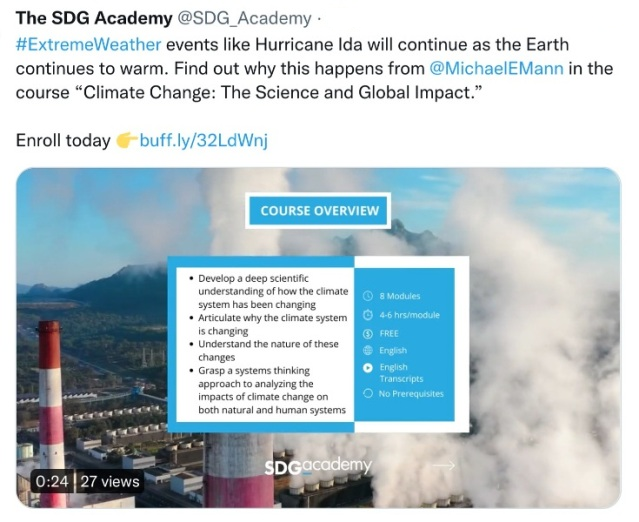File:Climate course at SDG (2022) recd by Michael E Mann.png
Climate_course_at_SDG_(2022)_recd_by_Michael_E_Mann.png (639 × 522 pixels, file size: 474 KB, MIME type: image/png)
Climate Change: The Science and Global Impact
We need to understand the science behind global warming to avoid the most damaging and irreversible climate change impacts on people and planet.
Estimated 8 weeks | 2–4 hours per week
Self-paced | Progress at your own speed
Free | Optional upgrade available
There is one session available: 24,481 already enrolled! After a course session ends,
Class Begins - Apr 29
Class Ends - Aug 31
Instructor
Michael E. Mann
Distinguished Professor of Atmospheric Science
Penn State University
What you'll learn
Principles of atmospheric science
Climate data collection and interpretation
Zero-dimensional Energy Balance Models
One-dimensional Energy Balanced Models
General Circulation Models
Carbon emissions scearios
Future climate change projections
Impacts on human systems
Emissions reduction pathways
Syllabus
Module 1: Introduction to Climate and Climate Change
- 1.0 Course Introduction
- 1.1 What is climate change
- 1.2 What should we care about climate change?
- 1.3 Overview of the climate system: How is the climate system constructed?
- 1.4 Overview of the climate system: How do energy balances work?
- 1.5 Overview of the climate system: Global circulation systems
- 1.6 Other fundamental principles: Feedback mechanisms and the carbon cycle
Module 2: Observing and Measuring Anthropogenic Climate Change
- 2.1 Changes in atmospheric greenhouse gases
- 2.2 Modern surface temperature trends
- 2.3 The oceans
- 2.4 Extreme weather
- 2.5 Sea ice, glaciers and global sea level
- 2.6 Paleoclimate evidence of climate change
Module 3: Modeling the Climate System: The Basics
- 3.1 Introduction to climate modeling
- 3.2 Expressing a zero-dimensional energy model as a linear equation
- 3.3 0d-EBM demonstration
- 3.4 Estimating climate sensitivity
Module 4: Modeling the Climate System: Advanced
- 4.1 One-dimensional energy balance models
- 4.2 Case Study: Using a one-dimensional EBM to model the ice ages
- 4.3 General circulation models
- 4.4 Validating climate models
- 4.5 Detecting climate change
- 4.6 Interpreting climate sensitivity
Module 5: Carbon Emission Scenarios
- 5.1 Emissions Scenarios
- 5.2 Stabilizing CO2 concentrations
Module 6: Applying Climate Models: Projected Changes in the Climate System
- 6.1 Surface temperature projections
- 6.2 Projected changes in global precipitation and drought
- 6.3 Atmospheric and oceanic circulation changes
- 6.4 The melting cryosphere
- 6.5 Sea level rise projections
- 6.6 Tropical cyclone and hurricane projections
- 6.7 Extreme weather projections
Module 7: Climate Change Impacts: The Future for People and Planet
- 7.1 Carbon cycle feedbacks
- 7.2 Sea level rise and coastal impacts
- 7.3 Ecosystems and biodiversity
- 7.4 Shifting water and food resources
- 7.5 Human health impacts
- 7.6 Security concerns
- 7.7 Tipping points
Module 8: What Is Our Path Forward?
- 8.1 Geoengineering: A scientist’s perspective, Part 1
- 8.2 Geoengineering: A scientist’s perspective, Part 2
- 8.3 Emissions reductions: The only viable way forward
- 8.4 Conclusion: A path of hope
🌎
File history
Click on a date/time to view the file as it appeared at that time.
| Date/Time | Thumbnail | Dimensions | User | Comment | |
|---|---|---|---|---|---|
| current | 18:06, 29 April 2022 |  | 639 × 522 (474 KB) | Siterunner (talk | contribs) |
You cannot overwrite this file.
File usage
The following page uses this file:
